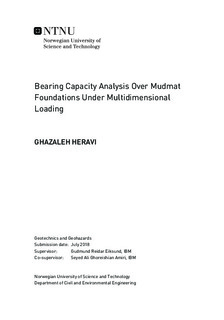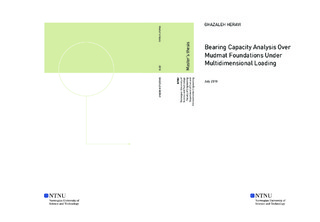| dc.description.abstract | The ultimate bearing capacity is at its maximum when the foundation is under pure vertical loading. In the field, pure vertical loading is the least likely load combination to happen but, it is mostly combined loading condition applying on a foundation which causes a bearing capacity reduction. The offshore condition is where a structure faces more various load combination of vertical, horizontal and moment loads in different directions.
This report determines the ultimate bearing capacity for different load combinations by using PLAXIS 3D which is a finite element(FE) software. Also, several hand calculations based on a method proposed by DNV is executed. The main idea of this thesis is to compare the results of analyses from PLAXIS or hand calculation.
The foundation is a rectangular mudmat foundation. It has outer skirts embedded for one meter in the soil and no inner skirts are modelled. The soil is assumed as soft clay which has its shear strength increasing with depth. The foundation plates are set elastic and rigid, so it won't fail under loading. Knowing that the plates and soil have interactions, so the interfaces are fully bounded therefore there will be no gap between the plate and soil due to loads on it. The transiently uplifting loads could be resisted by negative pore pressure due to the gap and it might compromise the assumption of untrained condition assumed in this case study.
The vertical bearing capacity of mudmat foundation resulted from PLAXIS 3D and hand calculation with the DNV method with a good approximation is the same. However, the horizontal bearing capacity differs slightly which seems to be due to the meshing system on PLAXIS which would lead to a more accurate answer if the mesh is finer. Also, assumption of roughness ratio as zero on hand calculation could be another reason. Second reason could be that PLAXIS 3D is modelling a three-dimensional environment while DNV method is based on a review through Hansen and Davis & Booker methods which are plane strain methods.
Analysing the model on PLAXIS is time taking. Having a proper computer with high analysing properties is a must to work in 3D environment. Generally, the results from FE software are more accurate when it is generated by elements which are smaller in length but more in number.
The assumption for hand calculation was not to have any tension loading though PLAXIS involves tension in the calculation. It is possible to use tension cut-off option on PLAXIS model as well. The model presented in this paper is having this condition to have comparable results. Hence, the failure path for moment loading in hand calculation and FEM results are expected to match. The results are closer when the moment is acting on the shorter edge than the longer one which is because of some forces on the 3D environment having the influence on the results which are not seen in hand calculation. Further studies over torsional and cyclic loading are recommended. | |

